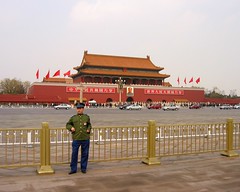At the moment I am about 2/3 of the way through Jared Diamond’s book “Guns, Germs, and Steel.” Basically it’s a history of human civilization written by a scientist, trying to uncover root the root causes for the success and failure of civilizations around the world while attempting to destroy the racist and culturalist theories behind the common ‘rise of the west’ narrative. With this rolling around in my head, here is my off the cuff (and in true blog style, completely unedited) attempt at a response to a post over on the blog Cominganarchy.com, in which Chirol argues that Arab cultural values are responsible for their current material backwardness. I don’t normally post this sort of thing here, but it may lead to some interesting comments.
It seems to me that the failure of the Arab world is not at heart a result of their culture, but their lack of significant exploitable natural resources aside from oil. Yes, oil makes a lot of money for them, but it requires only a very, very small percentage of the population to actually exploit it to its maximum potential, creating no incentive for the rest of the population to work. One could argue that in effect, the culture is backwards because there are few good ways for them to modernize in a material fashion.
Why is the West advanced and the Arab world behind? Due to the allocation of natural resources, the industrial revolution could only have happened in Western Europe (or possibly China), and the Middle East was too far away from deposits of iron and coal necessary for industrialization to make such innovations realistic. Only in the later stages of industrialization, when we began using engines that ran on liquid fuel instead of coal did the region have anything of material worth to offer the modern world, and it is only a single raw resource destined for export, not raw materials that could become the bases of a production oriented economy.
Oil is basically the only source of wealth in the Middle East, and it is for the most part controlled and profited from exclusively by the elites. Look at the Saudi family, and the former Saddam Hussein regime. The only places where most of the population is actually well off are those such as Dubai, where oil money is redistributed through a socialist benefits system that works because there’s so damn much money they don’t even have to worry about managing the economy. It’s not even ‘from each according to his ability, to each according to his need,’ everyone just gets free money without having to work at all. Sure, everyone gets a free education, even fully-subsidized study abroad if they want, but to what end? How many of the people you have met in your life would in fact work hard under such conditions, when failure presents no threat of want?
Regardless of whatever ‘cultural values’ people in the Middle East possess, I don’t see how their economies and societies can realistically modernize under the dual strangle hold of oil and autocratic government. If democracy genuinely takes hold in Iraq than we may have the opportunity to make an interesting experimental comparison, but it still remains to be seen how much the free oil money may retard genuine development there as well. Perhaps if they follow Norway’s example, and put the bulk of the money in a kind of trust fund and use some to fund contemporary development of other industries they will actually be able to succeed.
You cite above “Inability to accept responsibility for individual or collective failure” as a trait of “failing cultures.” It seems to me that in fact success and failure are to a large degree determined by ones environment, and the current environment of the Middle East, awash in oil but no other opportunities, is one which offers precious little hope for more than a small minority to improve their personal circumstances significantly. The other conservative social and religious values on your list make more sense when you realize that religion is primarily the refuge of the weak, there is nothing like the promise of Heaven to justify one’s sorry lot on Earth, and nothing like calling those who are more successful than you infidels or heretics to sooth one’s self esteem.




 The Zimmerli Art Museum, located on the campus of my alma mater, Rutgers University, has a well put together
The Zimmerli Art Museum, located on the campus of my alma mater, Rutgers University, has a well put together